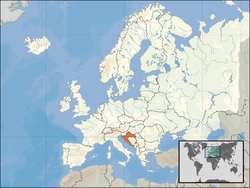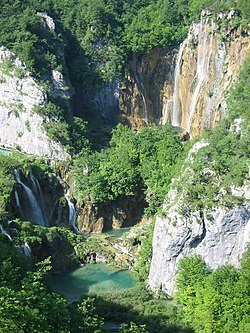This is an old revision of this page, as edited by 85.211.180.217 (talk) at 23:03, 17 May 2007 (→External links). The present address (URL) is a permanent link to this revision, which may differ significantly from the current revision.
Revision as of 23:03, 17 May 2007 by 85.211.180.217 (talk) (→External links)(diff) ← Previous revision | Latest revision (diff) | Newer revision → (diff)| Republic of CroatiaRepublika Hrvatska | |
|---|---|
 Flag
Flag
 Coat of arms
Coat of arms
| |
| Anthem: Lijepa naša domovino "Our beautiful homeland" | |
 Location of Croatia (orange) Location of Croatia (orange) | |
| Capitaland largest city | Zagreb |
| Official languages | Croatian |
| Government | Republic |
| • President | Stjepan Mesić |
| • Premier | Ivo Sanader |
| Independence | |
| • Founded | First half of 7th century |
| • Medieval duchy | March 4 852 |
| • Independence | May 21 879 |
| • Elevated to kingdom | 925 |
| • Union with Hungary | 1102 |
| • joined Habsburg Empire | January 1 1527 |
| • from Austria-Hungary | October 29 1918 |
| • SFR Yugoslavia dissolved | June 25 1991 |
| • Water (%) | 0,227% |
| Population | |
| • July 2007 estimate | 4,493,312 (115th) |
| • 2001 census | 4,437,460 |
| GDP (PPP) | 2007 estimate |
| • Total | $68,208 billion (70th) |
| • Per capita | $15,355 (53rd) |
| Gini (2001) | 29 low inequality |
| HDI (2004) | Error: Invalid HDI value (44th) |
| Currency | Kuna (kn) (HRK) |
| Time zone | UTC+1 (CET) |
| • Summer (DST) | UTC+2 (CEST) |
| Calling code | 385 |
| ISO 3166 code | HR |
| Internet TLD | .hr |
Croatia (Template:Lang-hr listen), officially the Republic of Croatia (Republika Hrvatska), is a country in Europe at the crossroads of the Mediterranean and Central Europe. Its capital is Zagreb. Croatia shares land borders with Slovenia and Hungary on the north, Serbia on the east, Bosnia and Herzegovina on the south and east, and Montenegro on the south, as well as a sea border with Italy to the west. It is a candidate for membership in the European Union and NATO.
History
Main article: History of Croatia
The Croats settled in the Balkans in early 7th century and formed two principalities: Dalmatia and Pannonia. The establishment of the Trpimirović dynasty ca 850 brought strengthening to the Dalmatian Croat Duchy, which together with the Pannonian principality became a Kingdom in 925 under King Tomislav.
In 1102, Croatia entered into a personal union with the Hungarian Kingdom. After the 1526 Battle of Mohacs the "reliquiae reliquiarum" of Croatia became a part of the Habsburg Monarchy in 1527.
In 1941-1945 an Axis puppet-state known as the Independent State of Croatia was set up, and after the victory of the Allies, Croatia became a constitutive republic of Yugoslavia.
Geography
Croatia is located in Southern Europe. Its shape resembles that of a crescent or a horseshoe, which flanks its neighbours Serbia, Bosnia and Herzegovina and Montenegro. To the north lie Slovenia and Hungary; Italy lies across the Adriatic Sea. Its mainland territory is split in two non-contiguous parts by the short coastline of Bosnia and Herzegovina around Neum.
Its terrain is diverse, including:
- plains, lakes and rolling hills in the continental north and northeast (Central Croatia and Slavonia, part of the Pannonian plain);
- densely wooded mountains in Lika and Gorski Kotar, part of the Dinaric Alps;
- rocky coastlines on the Adriatic Sea (Istria, Northern Seacoast and Dalmatia).
The country is famous for its many national parks. Croatia has a mixture of climates. In the north and east it is continental, Mediterranean along the coast and a semi-highland and highland climate in the south-central region. Offshore Croatia consists of over one thousand islands varying in size.
National Geographic Adventure Magazine named Croatia as Destination of the Year in 2006.
Politics
Main article: Politics of Croatia See also: Foreign relations of Croatia and Accession of Croatia to the European UnionSince the adoption of the 1990 Constitution, Croatia has been a democratic republic. Between 1990 and 2000 it had a semi-presidential system, and since 2000 it has a parliamentary system.
The President of the Republic (Predsjednik) is the head of state, directly elected to a five-year term and is limited by the Constitution to a maximum of two terms. In addition to being the commander in chief of the armed forces, the president has the procedural duty of appointing the Prime minister with the consent of the Parliament, and has some influence on foreign policy. His official residence is Predsjednički dvori.
Template:Croatia membership The Croatian Parliament (Sabor) is a unicameral legislative body (a second chamber, the "House of Counties", which was set up by the Constitution of 1990, was abolished in 2001). The number of the Sabor's members can vary from 100 to 160; they are all elected by popular vote to serve four-year terms. The plenary sessions of the Sabor take place from January 15 to July 15, and from September 15 to December 15.
The Croatian Government (Vlada) is headed by the Prime minister who has two deputy prime ministers and fourteen ministers in charge of particular sectors of activity. The executive branch is responsible for proposing legislation and a budget, executing the laws, and guiding the foreign and internal policies of the republic. Government's official residence is at Banski dvori.
Croatia has a three-tiered judicial system, consisting of the Supreme Court, county courts, and municipal courts. The Constitutional Court rules on matters regarding the Constitution.
The yearly Reporters Without Borders' press freedom rankings for Croatia from 2002 to 2006 are: 33rd · 69th · 54th · 56th · 53rd
Counties



Croatia is divided into twenty-one counties (županija) and the capital Zagreb's city district (in italics below):
| Anglicized name | Native name | |
| 1 | Zagreb | Zagrebačka |
| 2 | Krapina-Zagorje | Krapinsko-zagorska |
| 3 | Sisak-Moslavina | Sisačko-moslavačka |
| 4 | Karlovac | Karlovačka |
| 5 | Varaždin | Varaždinska |
| 6 | Koprivnica-Križevci | Koprivničko-križevačka |
| 7 | Bjelovar-Bilogora | Bjelovarsko-bilogorska |
| 8 | Primorje-Gorski Kotar | Primorsko-goranska |
| 9 | Lika-Senj | Ličko-senjska |
| 10 | Virovitica-Podravina | Virovitičko-podravska |
| 11 | Požega-Slavonia | Požeško-slavonska |
| 12 | Brod-Posavina | Brodsko-posavska |
| 13 | Zadar | Zadarska |
| 14 | Osijek-Baranja | Osječko-baranjska |
| 15 | Šibenik-Knin | Šibensko-kninska |
| 16 | Vukovar-Srijem | Vukovarsko-srijemska |
| 17 | Split-Dalmatia | Splitsko-dalmatinska |
| 18 | Istria | Istarska |
| 19 | Dubrovnik-Neretva | Dubrovačko-neretvanska |
| 20 | Međimurje | Međimurska |
| 21 | City of Zagreb | Grad Zagreb |
Economy
Main article: Economy of CroatiaCroatia economy is service based with service sector accounting for 67% of total GDP. Industrial sector is dominated by shipbuilding, food processing and chemical industry taking a significant portion of Industrial output.
Croatia's largest companies are Agrokor, Ina, Pliva, Podravka, HEP, Vindija and Croatian Telecom.
Industrial Sector represents 27% of Croatia’s total economic output and agriculture represents 6%.
Agricultural sector in Croatia started to thrive in recent years; exports of blue water fish experienced a surge in demand especially from Japan and South Korea. Croatia is a strong producer of organic foods and much of it as of late is being exported to EU as are Croatian wines, olive oils and lavender.
Tourism is a notable source of income during the summer. With over 10.4 million foreign tourists each year generating a revenue of over 7 billion euros, Croatia is ranked as eighteenth most popular tourist destination in the world.
Trade is starting to play a major role in Croatian Economic Output. In 2006 Croatia exported goods in value of 10.4 U$ billion (FOB) (19.7 billion including service exports.
The estimated Gross Domestic Product per capita in purchasing power parity in 2006 was cca. USD 15500 or 48.9% of the EU average for the same year.
Croatian preliminary GDP data for 2007, puts Croatian GDP at 68,208 billion USD, or just over 15,355 USD per head (Real income) putting Croatia ahead of EU member-states Romania and Bulgaria.
The Croatian economy is post-communist. In the late 1980s, at the beginning of the process of economic transition, its position was favorable, but it was gravely impacted by de-industrialization, war destruction as well as losing the markets of Yugoslavia and the SEV.
Persistent economic problems still remain: unemployment (11.9% in 2006) and slow progress of economic reforms. Of particular concern is the heavily backlogged judiciary system, combined with inefficient public administration, especially issues of land ownership. The unemployment is very high in eastern parts of Croatia (Slavonia and Dalmatia), reaching 20% in some areas, and relatively low in larger cities, Istria, Kvarner, Zagreb-area, being under 7%. Unemployment has been constantly declining by 5% over the last 7 years.
The country has since experienced faster economic growth and has been preparing for membership in the European Union, its most important trading partner.
In February 2005, the Stabilization and Association Agreement with the EU officially came into force and Croatia is advancing towards full EU membership. The country expects some major economic impulses and high growth rates in the coming years (currently Croatia suffers from high export deficit and considerable debt). Croatia is expecting a major boom in investments, especially greenfield investments.
Demographics

The population of Croatia has been stagnating over the last decade. The 1991–1995 war in Croatia had previously displaced large parts of the population and increased emigration. Some Croats who fled the country during the war are returning. The natural growth rate is minute or negative (less than ± 1%), as the demographic transition has been completed half a century ago. Average life expectancy is approximately 75 years, and the literacy rate is 98.5%.
Croatia is inhabited mostly by Croats (89.9%). There are around twenty minorities, Serbs being the largest one (4.5%) and others having less than 0.5% each. The predominant religion is Catholicism (87.8%), with some Orthodox (4.4%) and Sunni Muslim (1.3%) minorities.
The official and common language, Croatian, is a South Slavic language, using the Latin alphabet. Less than 5% of the population cites other languages as their mother tongues.
| Ethnicity | Population | % of total |
|---|---|---|
| Croats | 3,977,171 | 89.63 |
| Serbs | 201,631 | 4.54 |
| Bosnians | 20,755 | 0.49 |
| Italians | 19,636 | 0.44 |
| Hungarians | 16,595 | 0.37 |
| Albanians | 15,082 | 0.34 |
| Slovenes | 13,173 | 0.30 |
| Czechs | 10,510 | 0.24 |
| Roma | 9,463 | 0.21 |
| Montenegrins | 4,926 | 0.11 |
| Slovaks | 4,712 | 0.11 |
| Macedonians | 4,270 | 0.10 |
There is also a sizeable German/Austrian minority and also an increasing Chinese population in Zagreb and the other bigger cities, estimated at between 1,500 to 3,000.
Culture
Main article: Culture of CroatiaCroatian culture is based on a thirteen century-long history during which the country has attained many monuments and cities, which gave birth to a number of historical figures. The country includes six World Heritage sites and eight national parks. Among a list of notable people that came from Croatia are three Nobel prize winners, and numerous inventors. Some of the world's first fountain pens came from Croatia.
Croatia also has a place in the history of clothing as the origin of the necktie (cravat). The country has a long artistic, literary and musical tradition. Of particular interest is the diverse nature of croatian cuisine.
See also
- Communications in Croatia
- Holidays in Croatia
- Military of Croatia
- Protected areas of Croatia
- Tourism in Croatia
- Transport in Croatia
- Sport in Croatia
- Croatian War of Independence
- List of Croatians
References
- Template:Hr icon Agičić et al., Povijest i zemljopis Hrvatske, priručnik za hrvatske manjinske škole (History and Geography of Croatia, a handbook for Croatian minority schools), Biblioteka Geographica Croatica, 292 pages, Zagreb:2000 (ISBN 953-6235-40-4)
Notes
- http://www.sabor.hr/default.asp?jezik=2
- http://www.hnb.hr/statistika/e-ekonomski_indikatori.htm?tsfsg=15127d5832d6ac210a43438afd2fc966
- http://www.dzs.hr/Hrv_Eng/StatInfo/pdf/StatInfo2006.pdf
- http://www.answers.com/topic/croatia
Further Reading
- Ivo Banac, The National Question in Yugoslavia: Origins, History, Politics Cornell University Press, 1984.
- Sharon Fisher, Political Change in Post-Communist Slovakia and Croatia: From Nationalist to Europeanist New York: Palgrave Macmillan, 2006. ISBN 1-4039-7286-9
- Mirjana Kasapovic (ur.), Hrvatska politika 1990.-2000. Zagreb: Hrvatska politologija 2001.
- Pavol Demes and Joerg Forbrig (eds.). Reclaiming Democracy: Civil Society and Electoral Change in Central and Eastern Europe. German Marshall Fund, 2007. ISBN 978-80-969639-0-4
External links
- The Croatian government's official website @ vlada.hr
- Basic facts, website of the Croatian Ministry of Foreign Affairs
- Croatian National Tourist Board @ croatia.hr
- General information about Croatia @ www.hr
- Croatia - Overview of History, Culture, and Science
- Tourist attractions in Croatia
- Croatia Directory
- United Nations Development Programme: Croatia
- Croatian World Network (Croatia.org)
- State Institute for Nature Protection - Croatia
| International membership and history | |||||||||||||||||||||||||||||||||||||||||||||||||||||||||||||||||||||||||
|---|---|---|---|---|---|---|---|---|---|---|---|---|---|---|---|---|---|---|---|---|---|---|---|---|---|---|---|---|---|---|---|---|---|---|---|---|---|---|---|---|---|---|---|---|---|---|---|---|---|---|---|---|---|---|---|---|---|---|---|---|---|---|---|---|---|---|---|---|---|---|---|---|---|
Template:Slavic-speaking nations
| |||||||||||||||||||||||||||||||||||||||||||||||||||||||||||||||||||||||||
